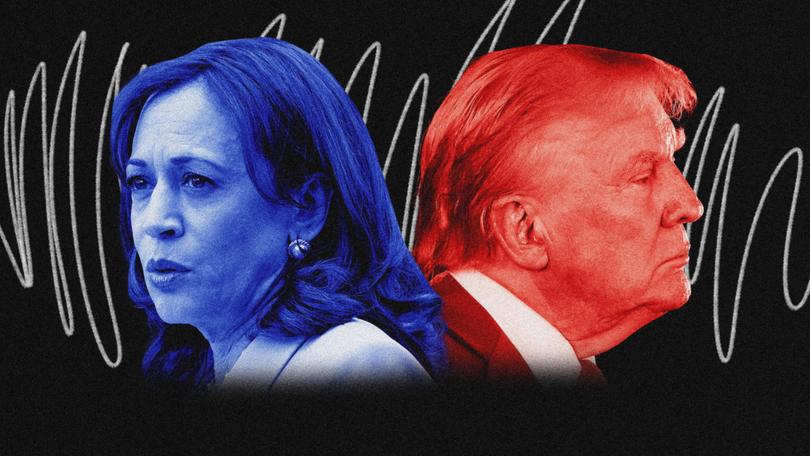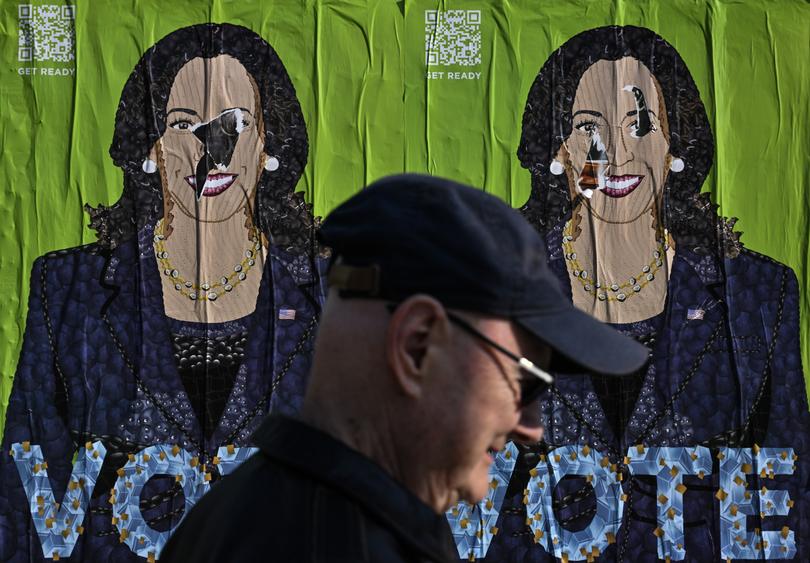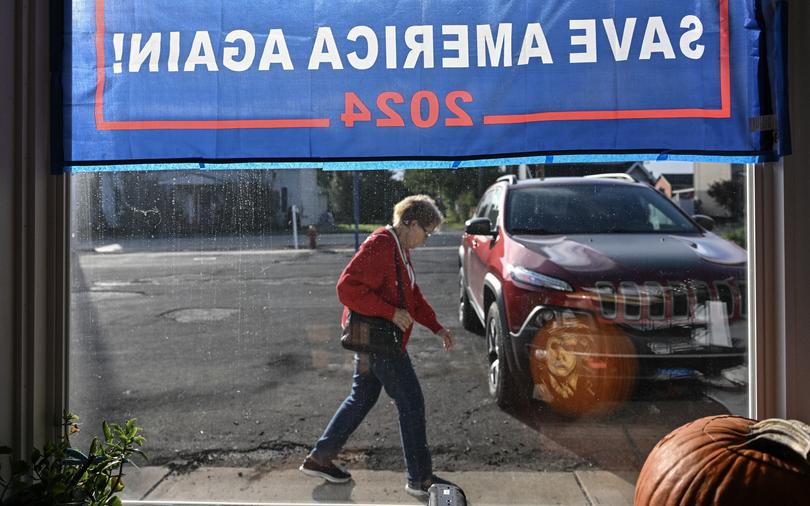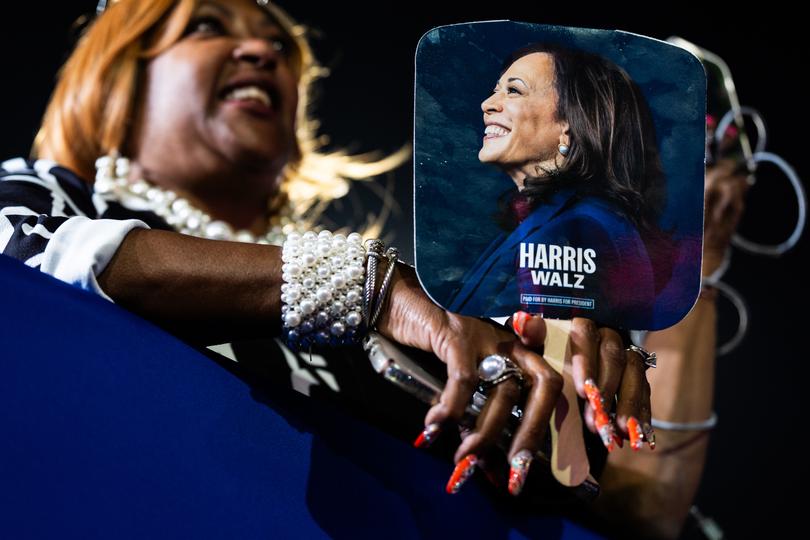THE WASHINGTON POST: Polls are tied, voters dig in and Harris, Trump scratch for any advantage

The closest presidential election in modern memory enters its final, frenetic days with neither Kamala Harris nor Donald Trump able to be confident of victory.
With tens of millions of early voters casting their ballots already, the outcome now depends on whether the campaigns can mobilize their bases and persuade the tiny fraction of the electorate still undecided about whom to support or whether to vote at all.
Neither Harris, the current vice president, nor Trump, the former president, has a lead outside the statistical margin of error in any of the seven battleground states of Arizona, Georgia, Michigan, Nevada, North Carolina, Pennsylvania or Wisconsin, according to a recent Washington Post-Schar School survey and The Post’s current poll average aggregator.
Sign up to The Nightly's newsletters.
Get the first look at the digital newspaper, curated daily stories and breaking headlines delivered to your inbox.
By continuing you agree to our Terms and Privacy Policy.Nor does either have a statistical advantage in national polls, which are a reflection only of the popular vote. National polls published Friday by the New York Times and Siena College and by CNN both showed a literal tie: 48-48 percent in the Times, 47-47 percent from CNN, both among likely voters. A Wall Street Journal poll showed Trump at 47 per cent and Harris at 45 per cent, including third-party candidates. These polls mark shifts, if ever-so-slight and still within the margin of error, in Trump’s direction over the past few weeks. But Democrats say they do not see any movement away from them and that the race remains extremely stable.
Both candidates are closing their campaigns with messages focused on fear. Harris, agreeing with former Trump officials that the former president should be labelled a “fascist,” argues that he represents an authoritarian threat to democratic institutions. She is also incorporating abortion and the threat to women’s rights as part of her closing message. Trump, meanwhile, is telling voters they should fear an influx of undocumented migrants who he says would drain the country’s resources and endanger people’s lives. On Friday he said America has become the world’s “garbage can.” It is an echo of the message he delivered on the day he first announced for president in June 2015.

Trump is the dominant politician of this era, and this election revolves mostly around him. All but a few voters know what they think of him, which is one reason the polls have been so stable and close. His defects are well-known to voters. Some who see him as flawed nonetheless believe their lives were better when he was in the White House. Others who are reluctant to support him still aren’t sure about Harris, about whom they know much less. Persuading more of them to entrust her with the presidency remains her biggest challenge.
Looking for clues
There have been other close outcomes in recent presidential elections. The 2016 and 2020 elections were decided by a relative handful of votes in a few states. The 2000 election went into 37 days of overtime before George W. Bush, with help from the Supreme Court, surmounted the 270 electoral vote threshold. In 2000 and in 2016, the winner of the electoral college, and thus the White House, actually lost the popular vote. But no one today has seen an election this close across all the battleground states heading toward Election Day.
Campaign leaders, as well as an army of strategists allied with the campaigns, are attempting to tease out from their data indications of where the race will end up. Their current focus has been to analyze patterns among the more than 36 million Americans who had cast early votes in person or by mail as of late Friday, according to Michael McDonald at the University of Florida Election Lab.
The early indications appeared favorable to Republicans, but in the past few days Democrats say they have seen positive signs for them. No definitive conclusions have been drawn yet about whether either candidate has an advantage in enthusiasm and eventual turnout.
Every presidential or midterm election since 2006, except for 2012, has resulted in some change in the balance of power in Washington, whether a party change in the White House or a party change in the House or Senate. In 2024, everything is up for grabs. Republicans appear on the cusp of seizing power from the Democrats in the Senate, even if by a narrow margin. In the House, Republicans are scrambling to protect their narrow majority against an assault from the Democrats.
The country remains in a sour mood. President Joe Biden’s approval ratings remain net negative, some of his policies are not especially popular, and there is a perception that the country is on the wrong track. Those conditions point to another election in which a desire for change is the driving force for many voters.

But Harris and Trump have both struggled to seize the mantle of change. She is tied to Biden administration policies and has not effectively explained how a Harris administration would be substantively different. Trump speaks the language of an outsider, but he is not a fresh or new face and the change he represents is a return to a past familiar to all - and worrisome to roughly half the electorate.
At this moment, Republicans express confidence in Trump’s chances, while there is angst among some Democrats. That is partly noise, given that the race is so close. In the closing days of the 2022 midterm elections, conventional wisdom (if not the polls) suggested that forces were converging to create a Republican red wave. In the end, the election did not conform to pre-balloting predictions. Abortion and fears about GOP extremism drove votes for Democrats, and Republicans were disappointed with their results, even though they narrowly won the House.
Several questions are yet to be answered that will help determine the outcome. One is whether Harris has more room to expand her support than Trump. In his two previous campaigns, Trump managed no better than 47 per cent of the popular vote. He won in 2016 because third-party candidates took almost 6 percentage points total. He lost in 2020 because third-party candidates took fewer than 3 percentage points of the total.
Biden won 51 per cent of the popular vote, three points better than Hillary Clinton in 2016.

His four-point margin over Trump was just enough to give him a slim victory in the electoral college. Trump is currently polling at about 47 per cent to 48 per cent in the national poll average. Can he move that up enough in a race where third-party candidates’ share is minimal to win? Or can Harris come close enough to Biden’s performance to translate that to victory in the electoral college?
“He certainly seems to have a ceiling nationally right at 47, based on the past elections,” said Republican pollster Whit Ayres. “You would think that Harris might have the potential to equal Joe Biden’s 51 per cent, but she hasn’t shown it yet.”
Paths to victory
Harris’s clearest path to an electoral college majority is to capture the three Great Lakes states - Michigan, Pennsylvania and Wisconsin - that long were part of the Democrats’ Blue Wall. (The Blue Wall, a term coined years ago by the Atlantic’s Ron Brownstein, was composed of 18 states and the District of Columbia, which had all voted Democratic in presidential races in six consecutive elections until Trump broke the wall in 2016.)
If Harris, like Biden, wins those three states but loses the other battlegrounds, that would put her at exactly 270, assuming she also wins an additional electoral vote in one of Nebraska’s two congressional districts. Harris’s strategy to win those states is roughly the same in all three: Maximize Black turnout and support in Philadelphia, Detroit and Milwaukee, and run up the numbers in the suburban counties that surround them.
In Pennsylvania, that means winning the collar counties around Philadelphia. In Michigan, it means winning big in Oakland and suburban Wayne counties and winning Kent County farther to the west. In Wisconsin, it means making further inroads in traditional Republican strength in the so-called WOW counties - Waukesha, Ozaukee and Washington - and counting on huge turnout and a massive margin of victory in heavily Democratic Dane County, which includes Madison.
Trump’s strategy in those three northern states is what it has been since 2016, which is to maximize his appeal in the small towns and rural areas, where turnout has increased dramatically since he became a candidate, while holding his own in the suburbs and making inroads among Black voters in the urban areas, or hoping that turnout sags.

Even if Trump carries the Sun Belt states of Georgia, North Carolina, Arizona and Nevada, he will still need one of those industrial states to win the election. Pennsylvania is the most significant prize of the three, if only because its 19 electoral votes are the most of any of the contested states. Were Harris to win Michigan and Wisconsin but lose Pennsylvania, she would then need to win either North Carolina or Georgia (each with 16 electoral votes) and win Nevada, which Trump lost by about 2 percentage points in his two previous campaigns.
The 2024 election is unique, and not just for the twists and turns that have occurred since Biden’s disastrous performance in his June debate with Trump and subsequent withdrawal from the campaign. Trump is the first nominee for president who has attempted to overturn the results of a losing election and still faces a pending indictment for what he did then. He is the first former president convicted of a crime - 34 felony convictions in his falsified business records case in New York. He is the first to have been held liable in a case of sexual assault. He is the first to have twice been impeached and acquitted while in office. He is also the first former president who lost the White House after a single term to seek a return since Grover Cleveland won his election in 1892 after losing in 1888.
If Trump’s third run for the White House limits his ability to be a true change candidate, perceptions of his first term nonetheless have helped him this fall. His retrospective approval rating - defined by whether people now approve or disapprove of how he did his job then - is higher than the ratings he received while in office. And many voters, even those who find him offensive in other ways, say their lives were better economically when he was president.
Harris is the fourth sitting vice president to seek the White House since 1960. Richard M. Nixon (1960), Hubert H. Humphrey (1968), George H.W. Bush (1988) and Al Gore (2000) all tried while in office. Only Bush was successful. Harris’s candidacy is also unique because she did not enter the race until July 21, barely 100 days before the election. Like Humphrey she became the nominee without competing in a single primary. She is also the first Black and South Asian female nominee for the nation’s highest office.
The fault lines
The fault lines in this election are sharply etched around both gender and education. There has been a gender gap in American politics for decades, with Republican nominees doing better with men and Democratic nominees doing better among women. But rarely have the campaigns been as singularly focused in their appeals.
Abortion has been the most potent issue in politics since the Supreme Court in 2022 ended the constitutional right to abortion. Harris has made the issue central to her candidacy, and it is a powerful energizing force, especially among women.
In addition, 10 states have ballot initiatives, most of which would make the right to abortion part of the state constitution. Since the Dobbs v. Jackson Women’s Health Organization decision, abortion rights supporters have won every ballot initiative, whether in blue states or red states. How much these initiatives will translate into Democratic support in the presidential race in battlegrounds like Arizona and Nevada is an open question.
Rarely has a candidate made such explicit appeals to men as Trump has. The last night of his national convention in Milwaukee featured the wrestler Hulk Hogan, singer Kid Rock and Dana White, CEO of the Ultimate Fighting Championship. Trump has tried to reach men through podcasts and other avenues, and his use of profanity and sexual innuendo on the campaign trail, offensive to many Americans, may register as appealing to some younger men.
The education fault line has been a defining characteristic of the Trump era. Once the party of the working class, Democrats have been losing ground for years among these voters. But Trump’s arrival as a candidate has accelerated the shifts, with more voters who do not have college degrees moving to support him and, just as significantly, those with college degrees, especially women, backing Democrats.

There are variations in the levels of support between men and women, with and without college educations, however. A Washington Post-Schar School survey of registered voters in the seven battleground states found that Trump led among men without college degrees by 17 points and among women without degrees by 3 points. Among those with degrees, Harris led among women by 20 points and among men by 8 points.
Whether by design or happenstance, the 2024 campaign appears to be a test of whether the Republican Party is moving to become not just a party of White, working-class voters, but of working-class voters more generally. Trump is making explicit appeals to Latino and Black men, particularly younger men. He appears to be making more progress in the Latino electorate than among Black voters in what Republicans hope may amount to an eventual realignment.
“He understands that the White working class alone is not a majority and is heading in the wrong direction as a share of the electorate,” said William Galston of the Brookings Institution. “But he and his campaign managers clearly believe that, in the politics of the next generation, class as defined as educational attainment will be more important than race and ethnicity.”
Republican pollster Patrick Ruffini, who has written about shifting coalitions in the electorate, said that in 2016, Trump’s focus was principally White working-class voters in the Rust Belt. “Now the [Republican] coalition has become more diverse,” he said. “We haven’t seen a strategy quite like this as a Republican.”
Ruffini said he believes there is a racial realignment underway that is not tied specifically to Trump. “But Trump is accelerating this,” he said. “I think we could see numbers we wouldn’t see for a decade or more if not for Trump.”
But Cornell Belcher, who was one of the pollsters for Barack Obama’s campaigns, believes the bigger problem for Harris is one of lethargy rather than defections. “I’m more worried about young African Americans sitting on the fence, undecided or deciding whether they will vote, than that they are breaking to him,” he said.
Belcher said that, if the electorate this year looks like that of 2020, Harris is the likely winner. “If it doesn’t look like it was in 2020, if the turnout of younger and more diverse voters and college-ed women, if that slips, he can get in,” he said of Trump.
The fight for control of Congress
Whatever happens in the presidential race, changes could be coming to the Congress. In the Senate, Democrats currently hold a two-seat margin. But they are almost certain to lose the seat held by retiring Sen. Joe Manchin III (West Virginia), with Republican Gov. Jim Justice heavily favoured in that race, which, if nothing else changes, would leave the Senate in a 50-50 split and the next vice president there to break any tie votes.
But Democrats could see more losses. The next most endangered Democratic seat is held by Sen. Jon Tester (Montana), who faces a stiff challenge from Tim Sheehy, a former U.S. Navy SEAL. Montana went for Trump by 16 points in 2020, and the Cook Political Report with Amy Walter currently rates the contest there as leaning Republican.
Republicans also have long seen Ohio’s Sen. Sherrod Brown (D) as vulnerable and have poured money and resources into the state to help elevate business executive Bernie Moreno, who won the Republican primary with Trump’s endorsement.

More recently, Republicans have set their sights on flipping seats in the three northern presidential battleground states. Two Democratic incumbents, Pennsylvania’s Bob Casey and Wisconsin’s Tammy Baldwin, are in toss-up races, and the contest in Michigan to replace the retiring Sen. Debbie Stabenow (D) also is close.
Republican Sen. Deb Fischer (Nebraska) faces a challenge from independent candidate Dan Osborn, who is running a populist campaign. And Democrats say that in Texas, Rep. Colin Allred has a chance to upset Republican Sen. Ted Cruz, though Republicans are confident that Cruz will hold the seat as he did in 2018, when he beat back a stiff challenge from Beto O’Rourke.
Republicans hold a slender majority in the House, with 220 seats, compared with 212 for the Democrats. There are three vacancies, two that were held by Democrats, one by Republicans. Democrats need to get to 218 seats to reclaim the majority they lost in 2020.
The Cook Report lists 14 Republican seats as toss-ups, including six in California and New York in districts Biden won in 2020 but where Democrats stumbled in 2022. Another GOP-held seat in New York is listed as leaning to the Democrats. But if Republicans lose seats in the two big blue states, they have opportunities to make up their losses elsewhere, with 11 Democratic-held districts listed as toss-ups by the Cook Report.
© 2024 , The Washington Post
